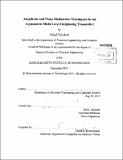Amplitude and phase modulation techniques for an asymmetric multi-level outphasing transmitter
Author(s)
Yahalom, Gilad
DownloadFull printable version (6.017Mb)
Other Contributors
Massachusetts Institute of Technology. Department of Electrical Engineering and Computer Science.
Advisor
Joel L. Dawson.
Terms of use
Metadata
Show full item recordAbstract
New techniques for improving outphasing transmitters show potential of breaking the traditional linearity-efficiency trade-off by using highly efficient non-linear switching Power Amplifiers (PAs). This work focuses on two of the main building blocks of modem outphasing systems, the power supply switching network and the phase modulator. Both are ubiquitous building blocks in modern RF transceivers, and both are especially critical in Asymmetric Multilevel Outphasing (AMO) systems. A design of the power supply network and control scheme is proposed for an implementation in mm-wave operating frequencies as part of a complete transmitter in 45nm SOI CMOS utilizing four discrete power supplies and achieving data rates of up to 4GS/s. The design includes analysis and simulation of the control signal data path requirements for optimal system operation as well as switch optimization and effects of the driving strength on overall system performance. A new design concept is proposed for a phase modulator utilizing the phase shifthing capabilities of a resonant tank and the ability to seperately control the circuit properties via its components. A prototype in 65nm CMOS achieves 12 bits of resolution, with an Effective Number Of Bits (ENOB) of 10.2 bits and very fast settling time of less than 5 carrier cycles. The chip is also tested as a stand alone transmitter showing an EVM of less than 5% for 8-PSK modulation at maximum data rate, meeting the requirements for operation at the Medical Implant Communication Services (MICS) band.
Description
Thesis (S.M.)--Massachusetts Institute of Technology, Dept. of Electrical Engineering and Computer Science, 2012. Cataloged from PDF version of thesis. Includes bibliographical references (p. 93-95).
Date issued
2012Department
Massachusetts Institute of Technology. Department of Electrical Engineering and Computer SciencePublisher
Massachusetts Institute of Technology
Keywords
Electrical Engineering and Computer Science.